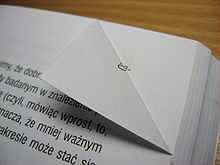Dog ears

A dog ear is a phrase that refers to the folded down corner of a book page. The name arises from the fact that wolves' ears stand erect while the ears of many breeds of dog flop over.[1] A dog ear can serve as a bookmark. While generally frowned upon by those that want to preserve books in their original condition, it is particularly common in use on paperbacks which are designed to be cheaper and more harshly used than hardcovers. Sometimes, it is also used to keep sheets of paper together, in the absence of a stapler or paper clip.
The phrase dates back at least to the late 18th century:
... those opinions quoted by the Hon. Gentleman from dog's-eared pages of pamphlets ...
Dog-earing is also commonly used to mark a section or phrase in a book that one finds to be important or of personal meaning.
Dog-ears can range in size from the tip of the page to half the page. Although people generally dog-ear the top section of pages (on either side), some also dog-ear on the bottom half of pages. Dog-ears work best on thin pages. Dog-ears may be unmade by folding it back into its original location and compressing the pages of the book together. Removing dog-ears is not recommended on paper that has yellowed from age, as it may cause the flap to separate from the page. Dog-earing more than one successive page can cause problems, as the flaps (depending on the thickness of the paper and the number of pages) may cause the marked sections to bulge and distort the book. Reference works are most prone to this problem.
References
- ↑ The Canine in Conversation
- ↑ Parliamentary Chronicle, Vol. XXIV, W. Stratford, London, 1799; page 359